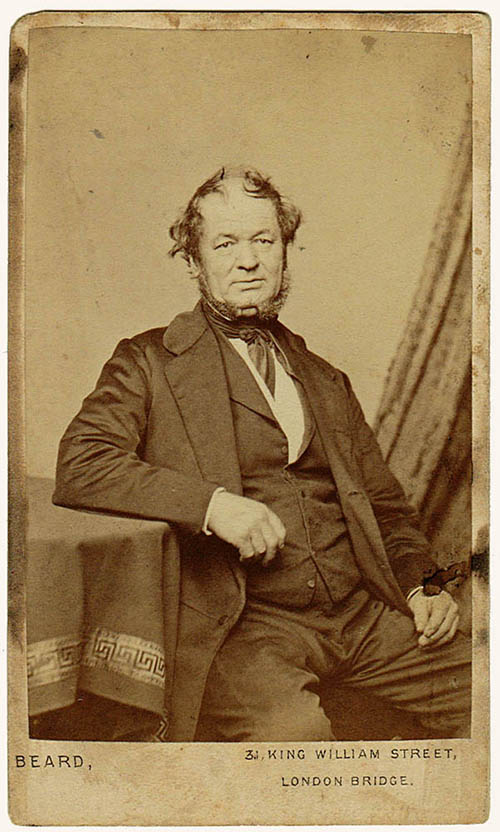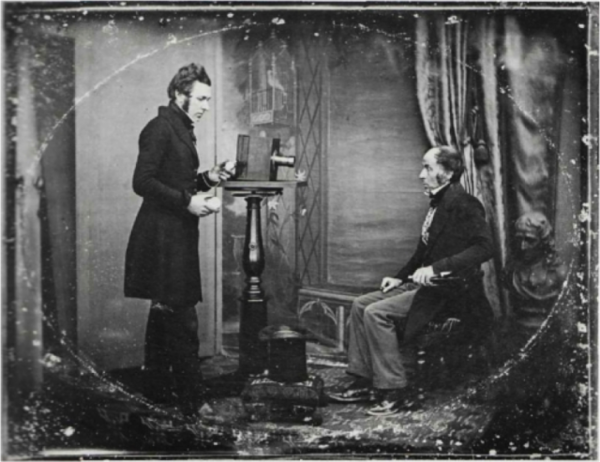On the 23rd of March, 1841, an enterprising patent speculator and coal merchant from Blackfriars, Richard Beard, opened the first professional portrait studio in England (and probably in Europe).

After the announcement of Daguerre’s invention in 1839, like Claudette, Beard had recognised the potential of commercial portraiture. During 1840, he experimented to make the daguerreotype process more practical, after realising that it was both optically and chemically possible to reduce exposure times.
In June 1840 Beard purchased the English patent for the American made Walcott mirror camera. This had the advantage of reflecting more light onto the plate during exposure, and also giving a true image, rather than a reversed one, as was the case with other cameras.
The scientist John Frederick Goddard discovered an effective accelerator, or quick stuff, as it was called, which speeded the emulsion on the plates. Goddard’s formula combined bromine and iodine vapour in the sensitising of plates and reduced exposure times to about two minutes.
Beard’s first photographic studio was built on the roof of the Royal Polytechnic institution, and was based on Alexander Walcott’s ‘Daguerrian Parlour’ in New York. Large movable reflectors were fixed outside the blue glass windows which redirected the sunlight onto the elevated seat, where the sitter posed with head reclining backwards.
The camera was placed about three metres in front of the sitter, the portraits produced were tiny, measuring only three by five centimetres.

Advice was given to the customers on having their portraits made too. Hints on what to wear, for example, ‘avoid white as much as possible’, ‘the best kind of dress to wear on such occasions, is a satin or silk shot or any material in fact, upon which there is a play of light and shade’. And; ‘If ladies must study for a bit of effect, we will give them a recipe for a pretty expression of the mouth’. Let them place it as if they were going to say ‘prunes’.
In the first months crowds flocked to have their likenesses taken. Beard’s takings were staggeringly high, portraits were sold at an 85% profit, and in June, 1841 beard shrewdly bought the daguerreotype patent for England, Wales, and the Colonies from Miles Berry for 800 pounds. Even then a small price to pay for a monopoly that was set to last 14 years.
Within the same month, Antoine Claudet, Beard’s great rival opened his portrait studio near Piccadilly Circus. Beard opened two more Studios in London in 1842 and provincial studios opened simultaneously in Liverpool, Birmingham, Southampton, Brighton, Manchester, Leeds Plymouth, and Norwich. He reaped high benefits by selling both the business, and the licence for the area to the highest bidder shortly after these studios started.
As word of Beard’s success spread people took up daguerreotype portraiture without paying him the licence fee, he employed an agent provocateur to gather evidence and brought several lawsuits against these infringers.
One such case against John Egerton of Whitechapel was to last five and a half years. The longest lawsuit in English photographic history. Although all Beard’s portrait studios were profitable, the excessive costs of protracted lawsuits led to his downfall, and in October 1949, he was forced to apply for bankruptcy. He made one last attempt to continue in 1958 by introducing everlasting enamel daguerreotype portraits, which he hoped would put him back in the forefront of the art. This was not to be, and beard was forced to watch his rivals prosper from the business he had once led.
